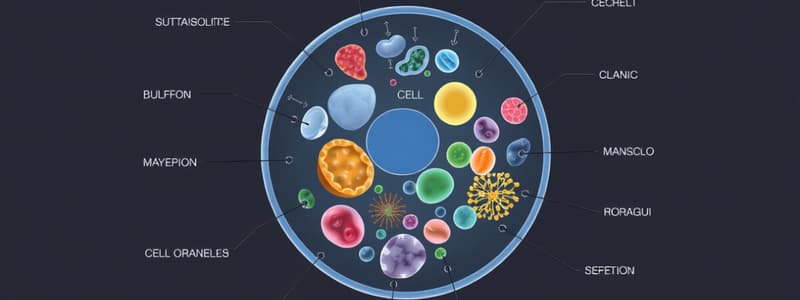Podcast
Questions and Answers
What are the major components of the cell membrane?
What are the major components of the cell membrane?
Phospholipids, proteins, cholesterol
Which of the following statements are part of the modern principles of Cell Theory? (Select all that apply)
Which of the following statements are part of the modern principles of Cell Theory? (Select all that apply)
- The cell is the structural and functional unit of all living things. (correct)
- All cells come from pre-existing cells by division. (correct)
- All known living things are made up of cells. (correct)
- Cells can spontaneously generate.
The phosphate head of a phospholipid is hydrophobic.
The phosphate head of a phospholipid is hydrophobic.
False (B)
What model did S.J. Singer and Garth Nicolson propose in 1972?
What model did S.J. Singer and Garth Nicolson propose in 1972?
Which factor does NOT influence cell membrane fluidity?
Which factor does NOT influence cell membrane fluidity?
What role does cholesterol play in the cell membrane?
What role does cholesterol play in the cell membrane?
The interior of all cells is separated from the outside environment by the ______.
The interior of all cells is separated from the outside environment by the ______.
Match the following components of the cell membrane with their characteristics:
Match the following components of the cell membrane with their characteristics:
Study Notes
Cell Theory Principles
- All known living organisms consist of one or more cells.
- Cells are the basic structural and functional units of life.
- New cells arise only from the division of pre-existing cells, negating spontaneous generation.
- Cells carry hereditary information that is transferred during cell division.
- Chemically, all cells are fundamentally similar.
- Metabolism and biochemical processes essential for life occur within cells.
Cell Organelles
- Organelles are subcellular structures performing specific tasks, similar to organs in a body.
- Basic structures present in all cells include:
- Cell membrane: outer boundary of the cell.
- Genetic information such as DNA.
- Cytoplasm: fluid between the cell membrane and the nucleus.
- Ribosomes: sites for protein synthesis.
Cell Membrane
- Functions as a biological barrier that separates a cell's interior from its external environment.
- Selectively permeable, regulating the entry and exit of ions and organic molecules.
- Composed primarily of phospholipid molecules forming a bilayer.
- Misconceptions about cell walls include the assumption they provide strength; instead, the cell membrane maintains homeostasis.
Structure of Cell Membrane
- Phospholipids consist of glycerol, two fatty acids, and a phosphate group, exhibiting amphiphatic properties.
- The phosphate "head" is hydrophilic (attracted to water), while the fatty acid "tails" are hydrophobic (repelling water).
- The fluid mosaic model, proposed by S.J. Singer and Garth Nicolson in 1972, illustrates the membrane's dynamic nature.
Fluid Mosaic Model
- The membrane features various molecules, including integral proteins, peripheral proteins, glycoproteins, and cholesterol.
- Integral proteins deeply penetrate the lipid bilayer, while peripheral proteins remain on the surface.
- The mosaic aspect signifies the diverse arrangement of these molecules within the phospholipid bilayer.
Membrane Fluidity Factors
- Temperature affects phospholipid movement; lower temperatures cause tighter packing, while higher temperatures increase distance between molecules.
- Cholesterol stabilizes membrane fluidity by preventing phospholipids from packing too tightly or spreading too far apart.
- Fatty acid composition influences fluidity:
- Saturated fatty acids create straight chains that pack tightly.
- Unsaturated fatty acids contain kinks from double bonds, preventing tight packing and enhancing membrane fluidity.
Studying That Suits You
Use AI to generate personalized quizzes and flashcards to suit your learning preferences.
Related Documents
Description
In this quiz, learners will explore the major cell organelles and their functions as described in Biology I Lesson 2. The quiz will cover the principles of Cell Theory, detailing how living organisms are composed of cells, the significance of cells as structural units, and the process of cell division.



